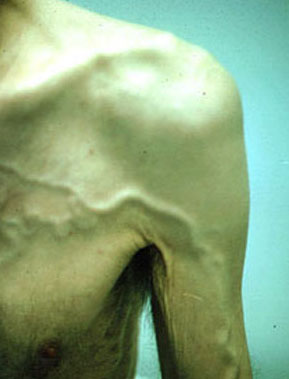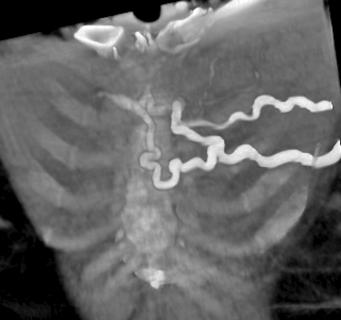Superior vena cava syndrome: Difference between revisions
No edit summary |
No edit summary |
||
| Line 38: | Line 38: | ||
==Signs and symptoms== | ==Signs and symptoms== | ||
The most common symptoms are these: | |||
*[[Dyspnea]] | *[[Dyspnea]] | ||
* | * Cough | ||
* | * Swollen face, neck, upper body, and arms. | ||
* | |||
* | Less common symptoms include the following: | ||
*[[ | |||
*[[ | * Hoarse voice. | ||
* Chest pain. | |||
* Problems swallowing and/or talking. | |||
* Coughing up blood. | |||
* Swollen veins in the chest or neck. | |||
* Bluish color to the skin. | |||
* Drooping eyelid. | |||
* [[Headache]] | |||
* Facial [[plethora]] | |||
* [[Lightheadedness]] | |||
Superior vena cava syndrome usually presents more gradually with an increase in symptoms over time as malignancies increase in size or invasiveness.<ref name="emedicine">{{cite web | last = Beeson | first = Michael S | title = Superior Vena Cava Syndrome | url=http://www.emedicine.com/emerg/topic561.htm | accessdate = 2008-03-24 }}</ref> | Superior vena cava syndrome usually presents more gradually with an increase in symptoms over time as malignancies increase in size or invasiveness.<ref name="emedicine">{{cite web | last = Beeson | first = Michael S | title = Superior Vena Cava Syndrome | url=http://www.emedicine.com/emerg/topic561.htm | accessdate = 2008-03-24 }}</ref> | ||
Revision as of 00:11, 16 January 2009
Template:DiseaseDisorder infobox
| Cardiology Network |
 Discuss Superior vena cava syndrome further in the WikiDoc Cardiology Network |
| Adult Congenital |
|---|
| Biomarkers |
| Cardiac Rehabilitation |
| Congestive Heart Failure |
| CT Angiography |
| Echocardiography |
| Electrophysiology |
| Cardiology General |
| Genetics |
| Health Economics |
| Hypertension |
| Interventional Cardiology |
| MRI |
| Nuclear Cardiology |
| Peripheral Arterial Disease |
| Prevention |
| Public Policy |
| Pulmonary Embolism |
| Stable Angina |
| Valvular Heart Disease |
| Vascular Medicine |
Editor-In-Chief: C. Michael Gibson, M.S., M.D. [1]
Please Take Over This Page and Apply to be Editor-In-Chief for this topic: There can be one or more than one Editor-In-Chief. You may also apply to be an Associate Editor-In-Chief of one of the subtopics below. Please mail us [2] to indicate your interest in serving either as an Editor-In-Chief of the entire topic or as an Associate Editor-In-Chief for a subtopic. Please be sure to attach your CV and or biographical sketch.
Overview
Also known as: SVC syndrome
Superior vena cava (SVC) syndrome is the obstruction of the superior vena cava resulting in diminished venous return from the head, neck and upper extremities. The Scottish obstetrician and anatomist, William Hunter, first described the entity in 1757, noting it as a complication of a syphilitic aortic aneurysm.
Epidemiology and Demographics
Most SVC syndromes in the present day are related to malignancy. An underlying malignancy is found in approximately 90% of patients.
Pathophysiology & Etiology
Collaterals form over time via the mammary, vertebrals, azygous and lateral thoracic veins, so despite almost or complete occlusion of the SVC venous drainage still can occur. Cerebral edema and obtundation with raised intracranial pressure is, therefore, rare. However, if this rare presentation is noted or if the airway is compromised, SVC syndrome represents a medical emergency.
Natural History
In the past, SVC syndrome was a medical emergency and empiric radiation was given to shrink the tumor. With the advent of better medical therapy for some lung cancers and lymphoma and the low morbidity associated with diagnostic procedures, this approach has fallen out of favor.
Signs and symptoms
The most common symptoms are these:
- Dyspnea
- Cough
- Swollen face, neck, upper body, and arms.
Less common symptoms include the following:
- Hoarse voice.
- Chest pain.
- Problems swallowing and/or talking.
- Coughing up blood.
- Swollen veins in the chest or neck.
- Bluish color to the skin.
- Drooping eyelid.
- Headache
- Facial plethora
- Lightheadedness
Superior vena cava syndrome usually presents more gradually with an increase in symptoms over time as malignancies increase in size or invasiveness.[1]
Diagnosis
The current strategy is to embark on a search for the primary source of the tumor. Start with a chest x-ray as a screening tool followed by a CT scan with contrast to further define the anatomy, extent of compression and to guide biopsy if a diagnosis cannot be made less invasively, e.g. thoracentesis, sputum, lymph node, and bone marrow biopsy.
Differential Diagnosis
The leading cancers associated with SVC syndrome are bronchogenic lung cancer (particularly small cell lung cancer), breast cancer, and lymphoma.
Benign causes of SVC syndrome include mediastinal fibrosis, histoplasmosis, radiation therapy complications, retrosternal goiter, Behcet’s syndrome, and thrombosis due to indwelling catheters or pacemakers. In the past, Tuberculosis and Syphilis were major players.
History and Symptoms
The presentation depends on the degree of occlusion and the rapidity with which it develops. The most common symptoms are dyspnea, facial swelling/fullness (suffusion) and cough. The most common signs are venous distention of the neck and chest wall and facial edema. Less commonly, chest pain, dysphagia, proptosis, hemoptysis, glossal edema, hoarseness, and headache are described. Symptoms get worse with leaning forward, coughing or lying down. Typically symptoms are present for >3 months before diagnosis.
Physical Examination
Appearance of the Patient
Pemberton’s Sign: suffusion, plethora, or duskiness that develop upon elevation of the arms above the head in patients with SVC syndrome.
Vital Signs
Skin
The skin of the face may have plethora.
There may be distension of veins on the torso.
Ear Nose and Throat
There is swelling of the face.
Laboratory Findings
Chest X Ray
This is a useful test to exclude lung cancer
MRI and CT
Useful in evaluating source and extent of a neoplasm.
Other Diagnostic Studies
Biopsy may be neccessary to evaluate the underlying cause.
Risk Stratification and Prognosis
SVC syndrome is rarely fatal, and the prognosis is generally related to the prognosis of the underlying malignancy rather than the presence/absence of venous obstruction.
Treatment
Pharmacotherapy
Acute Pharmacotherapies
The goal of therapy is to relieve the obstructive symptoms and address the underlying process. Removal of nonessential central lines and upright posture are initial measures. Diuretics, steroids, radiation and chemotherapy are used depending on clinical scenario. In the case of compression, anticoagulation and stent placement are accepted means of attempting to assure long-term patency and prevent propagation. [2] [3] [4]
Surgery and Device Based Therapy
Stenting may be neccessary to preserve patency.
References
- ↑ Beeson, Michael S. "Superior Vena Cava Syndrome". Retrieved 2008-03-24.
- ↑ Nieto AF, Doty DB. Superior vena cava obstruction: clinical syndrome, etiology, and treatment. Curr Probl Cancer 1986; 10:441-84.
- ↑ Yellin A, Rosen A, Reichert N, Lieberman Y. Superior vena cava syndrome. The myth--the facts. Am Rev Respir Dis 1990; 141:1114-8.
- ↑ Chen JC, Bongard F, Klein SR. A contemporary perspective on superior vena cava syndrome. Am J Surg 1990; 160:207-11.
See also
Acknowledgements
Source of Initial Content: Morning report notes prepared by Dr. Duane Pinto, C. Michael Gibson, M.S., M.D.

